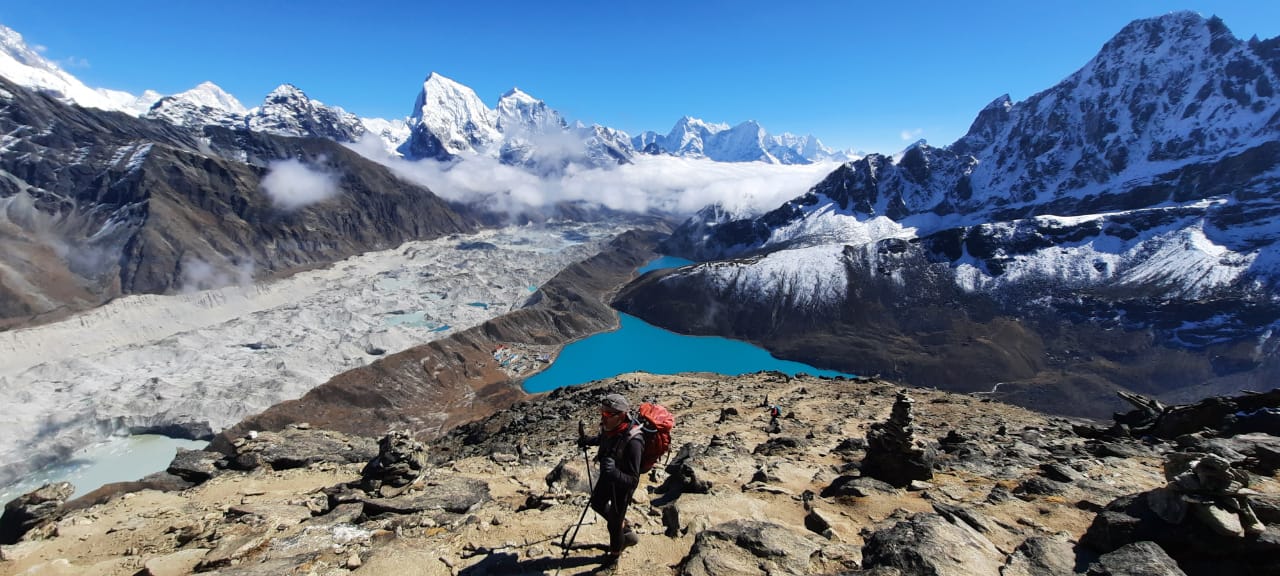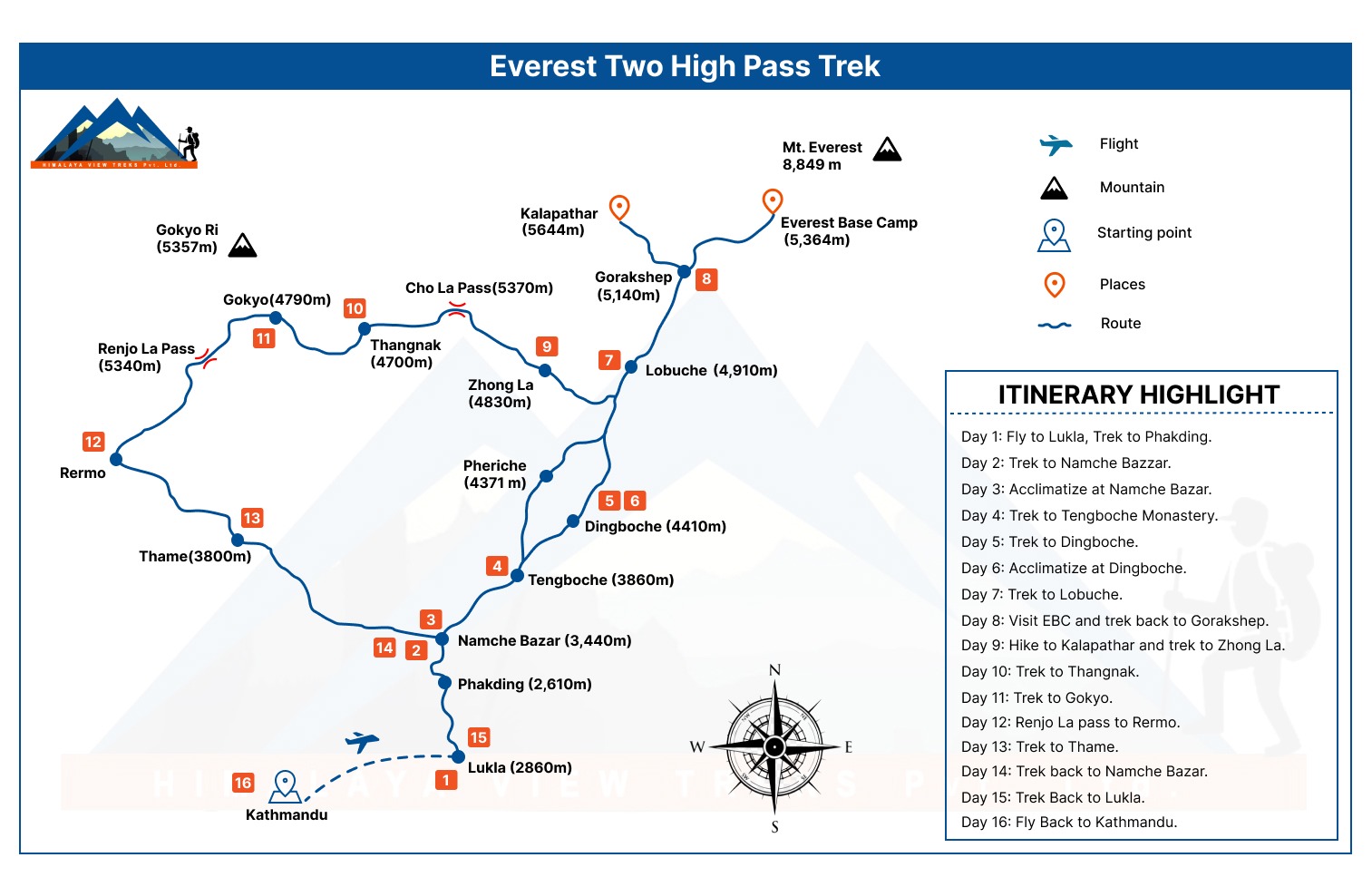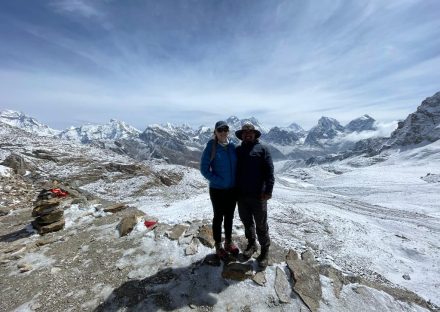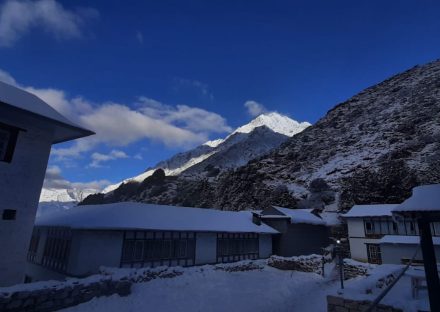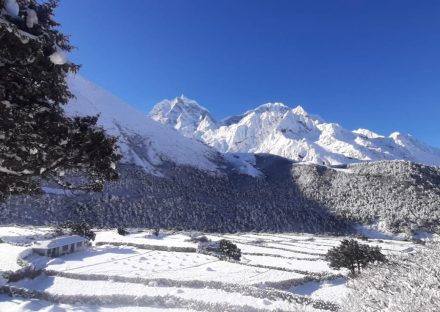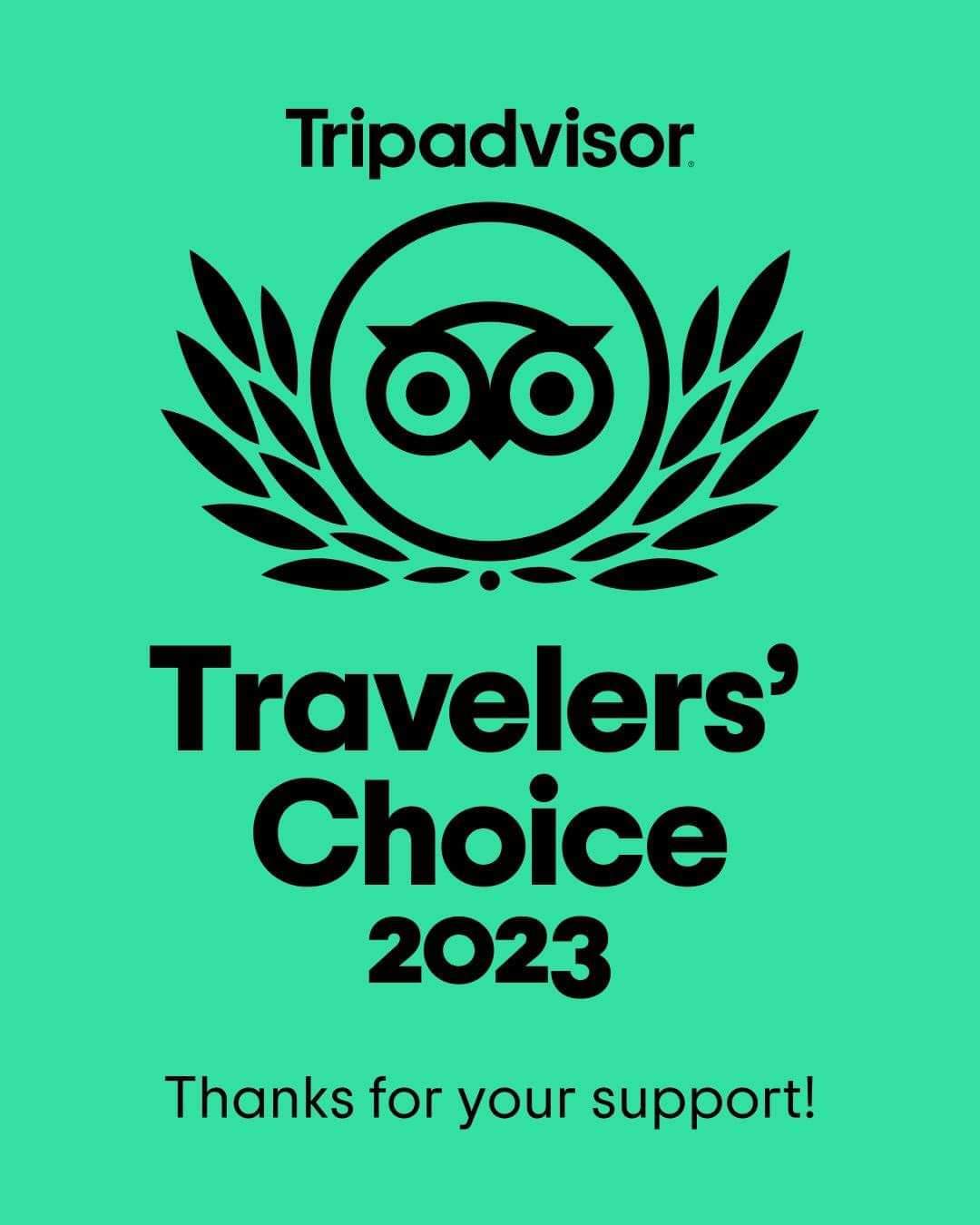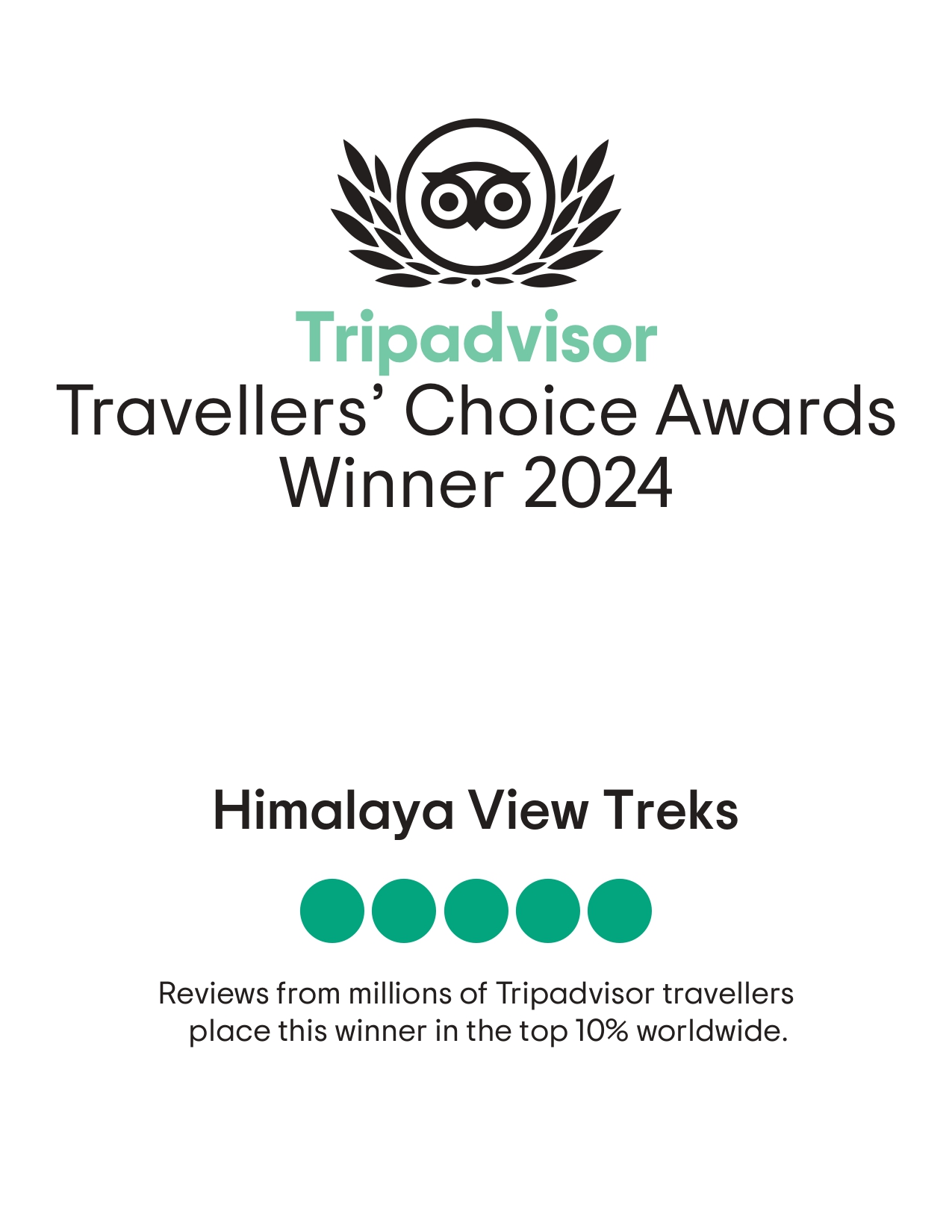Trip overview
Everest Two High Passes Trek
Scenic journeys to Everest region of Nepal Trekking, Everest two high pass trek Chola 5420 m. and Renjola 5360 m. Pass is the wildest walker holiday activity.
Everest 2 high pass trek also you can continue from Lukla to all the ways Everest camp base camp. It starts after the short flight from Kathmandu. After reaching the new Everest Base Camp (5364 m) and Kalapatthar (5545 m) you will be apart from the main trail. Chola pass is (5420 m) the first pass on the trail. Moreover, you will get a closer view of the top of the world’s highest peak Mount Everest. Similarly, you get to see more than 100 snow-capped names as well as unnamed Mountains. The elevation of the Chola Pass (is 5420 m) and the Renjola Pass is ( 5360 m).
Explore 2 High Passes Trek (Chola & Renjola) & Lakes (Gokyo) in Khumbu
After the Chola Pass (5420 m) you will reach the beautiful lakeside of the Gokyo valley, Gokyo Lake lays the beautiful Sherpa hamlet blessed by the magnificent sunrise viewpoint hill of Gokyo Ri (5357 m). Trekkers trek to Fifth Lake as well during this adventure walking holiday in the Everest region of Nepal. After the Gokyo stay you need to prepare another high Pass challenge Renjola Pass ( 5360 m) Renjola Pass is a bit less challenging than the Chola Pass.
Renjola Pass to Thame Valley where you will see the way to Tibet and will join this trail in Namche bazaar to Lukla and fly out Ton Kathmandu, in this way your Everest two high pass trek will finish.
Get the best walking holiday package in Nepal with Trekking to Everest. Highly experienced trekking guides and local way of managing things make your Everest two Pass via Base camp of Everest and Gokyo Lake Trekking an informative and adventurous journey of your lifetime. Moreover, the Everest high passes trek is calling and choosing the experts for such high-altitude adrenaline-rushing adventures in Nepal.
Short Itinerary
Two Passes Trek Itinerary - 16 days
Day 01 Fly to Lukla and then trek to Phakding 2,860 meters/9184ft) walking distance of 6.2 km (3-4 Hours)
Day 02: Trek from Phakding to Namche Bazaar 3,440m/11,283ft) walking distance is 7.4 km (5-6 Hours)
Day 03: Acclimatization Day, Hike to Everest View Hotel 3880m/13000ft, and then back to Namche
Day 04: Trek from Namche to Tengboche 3,870m/12,684ft)walking distance 5.9 km (6 hours)
Day 05: Trek from Tengboche to Dingboche 4,400m/14,435ft) walking Distance 9.1km (6 hours)
Day 06 Dingboche Acclimatization Day, climbing the (5100 m) hill of Nagarshan (2/3 Hours) 4,400m/14,435ft and then back to Hotel
Day 07: Trek from Dingboche to Lobuche (4,900m/16,076ft) Walking distance 10 km (6-7 hours)
Day 08: Trek from Lobuche to Gorakshep 4 km (6-8 hours) 5180m/16,994ft (Gorekshep) and then visit Everest base camp 5364m/17598) Via Khumbu Glacier)
Day 09: Hike to Kalapatthar and then trek to Zhong La walking distance 10.5km (5-6 hours) 5,545m/18,192ft (Kalapathar) & 4,830m/15842Ft (Zhong La)
Day 10: Trek to Thannak 4700m/15416ft) via (Chola Pass 5417m/17767ft)walking distance 9.4km (6/7 hours)
Day 11: Trek to Gokyo Lake (4760m.15612ft) walking distance 3 hours
Day 12: Trek to Lunden 4300m/14103 ft) via (Renjo pass 5360m/17580ft) walking distance 6/7 hours
Day 13: Trek to Thame walking distance 6.8 km (4 hours) 3800m/12464ft
Day 14: Trek to Namche Bazaar 3,440m/11,283ft) walking distance is 7.4 km (5-6 Hours)
Day 15: Trek back to Lukla 2800m/9184ft) walking distance of 13.5 km (6/7 hours)
Day 16: Fly back to Kathmandu early in the morning around 07:00 AM (35 minutes)
Included
- Airport pickup and drop as per client’s arrival and departure date
- Hotel- domestic airport- hotel by car/ van, depend on group sizes
- Both ways Flight Ticket Lukla - Kathmandu) tickets including airport taxes
- All meals (Breakfast, lunch, and dinner) during your Everest 2 pass Trek
- 15 nights Hotel Accommodation during Everest 2 pass Trek
- Government licensed holder, fluent English Speaking, Familiar HVT guide
- One assistant guide if Group sizes is more than 10 trekkers)
- Strong local Porters for Carry trekker’s luggage One porter every 2 trekkers
- Guide and porter wages including their meals, accommodation, and Salary
- Staff insurance including medication coverage
- Guide and Assistance flight Ticket
- Equipment for the Company staff
- Water purification drop or tablets for safe drinking water
- Sagarmatha National Park entry permit fee
- Khumbu Pashang Lhamu Rural Municipality permits fees
- Seasonal fresh fruits every day during Everest 2 pass trek
- Oximeter to measure Pulse and oxygen level
- Company T-shirt as a Souvenirs, and duffle bag if needed
- Local government, taxes, including official Service Charge
- Trip completion Certificate
Not Included
- Hotel accommodation and meals In Kathmandu.
- Personal expense (shopping, snacks, boil bottle water, hot (tea, coffee) and cold drinks, hot shower, alcohol, Wi-Fi, telephone call, battery charge fee during the Everest twoTrek)
- Personal clothing and trekking gear
- Personal travel insurance including evacuation coverage (compulsory) up to 6000m)
- Additional costs if delays flights and outside the itinerary
- All the costs and expenses which are not mentioned in includes list.
- Tips for guide and porters. in end of the treks
Useful Info
Best Time of The Year
Doing this trek/climb at the right time is very important to the success of a trip of this kind. Spring (March-May) and autumn (October-November) are really the best seasons to do this trek. The monsoon season (June - early September) has less predictable weather, but some trekkers still choose this time as it aligns better with their vacation schedule. The Winter season (December - February) gets pretty cold, and snow may block the passes, but often offers clear skies. Nonetheless, we suggest our guests make bookings for this venture in the spring or autumn, especially in the autumn of September/October. The weather is at its best for this high-altitude trip. The views are crystal clear with sparkling blue skies & the finest weather you could ever imagine.
Difficulty on this odyssey
The two passes trek is rated “Challenging”. It is a very arduous adventure given its high pass crossings. This venture is more challenging than its sibling treks Everest Base Camp and Gokyo Lakes, but not as much challenging as trekking peaks such as Island Peak and Mera Peak. Nevertheless, doing this trip requires real good physical fitness & previous experience of trekking above 4500m.
Accommodation & Meals
The Everest Region has admirable infrastructure for trekkers. The teahouses (lodges) are of relatively high quality and they serve good meals, especially in Namche Bazar which you’ll pass on the way up and down.
Variations
Generally, it’s best to complete the Two Passes trek counter-clockwise. It is possible to go clockwise, as well, but not recommended due to the steep altitude gain of crossing the Renjo La, first. From Gokyo, you can also add an extra day to visit the remote Gokyo Lakes farther up the glacial valley. However, whichever way you start, there’s an altitude to gain on all 3 high passes.
Will I need travel insurance?
It’s mandatory and highly recommended to get travel insurance before embarking on any adventurous trips in Nepal.
We advise all our clients to get travel insurance that covers emergency helicopter evacuation that may be needed in case of the occurrence of AMS (Acute Mountain Sickness) or any other reasons in high altitudes where there are no other means of transportation available. It is advisable to review carefully the insurance and its coverage before making the final decision. Carry proof of your insurance with you on the holiday and leave a copy next to your kin. You must ensure that your insurance provides an adequate level of protection and covers you well for the activities involved.
FAQs
-
How difficult is the 2 passes trek?
The Everest High Passes Trek is also known as the Three Passes Trek or Everest Base Camp via Three Passes Trek or High Land of Everest Valley Trek. It is one of the hardest trips that Himalaya View Treks provides to its bold & brave trekkers and adventure-seekers. The journey is known to be a complete circle of high alpine country within the Everest Valley following the treacherous three passes of Renjo La, Cho La and Kongma La before Everest Base Camp visit. The taxing trip is indeed a long walk in remote land, high up in the mountains in the middle of nowhere. For this adventurous trek, you must be very fit and highly experienced in the Himalayas. We highly recommend trekkers and keen hikers to first do the Everest Base Camp Trek or Gokyo Lakes Trek before making a go for this one. Following this adventure pattern could make your issues a lot more comfortable for the 3 high passes. Once you’re done with the high passes, you can graduate for the big time peaks like ‘Island peak or Mera peak’’ & then target the 7 thousanders from there on, if you’re an ardent mountaineer. However, if you are a tested trekker or have already experienced the Kilimanjaro Climb or trekked in the Andes or on the Alps, then you are unquestionably eligible for this one.
-
When is the best time to do the 2 passes trek?
Everest High Passes Trek is best done in pre-monsoon season i.e. from March to May and post-monsoon season i.e. from late September to December. It is also possible to do this trek in February and early September but the trek is best preferred in early autumn. September/October would be ideal & wonderful.
-
Is my trip departure guaranteed?
Absolutely yes! Under normal circumstances, our booked trips are guaranteed to run. You will still be doing your trek even if other trekkers cancel their trip. This is the reason why Himalaya View Treks is small but highly dependable; we’re somewhat different from other agencies, who usually cancel their whole trip a month or even a week before the trip date. We are a tailor-made outfit and the number of participants does not stop our operation. If your trip has been canceled by your operator and you are on a last-minute stress mode, remember to find us to sort out your trip decisions. Please feel free to book your stress-free holidays with us. Unless there is a situation which is beyond our control i.e. a political riot, natural disasters, pandemics, epidemics or weather catastrophes affecting one & all, our trips are 100% guaranteed to run.
-
If I cancel my trip, will I get a refund?
Himalaya View Treks offers a lifetime deposit policy which allows you the flexibility to transfer your deposit to anyone or any other trip. If you wish to cancel your booked trips, certain cancelation charges apply. Please visit our booking terms and conditions for detailed information.
-
Who are my guides, are they experienced enough for such a trip?
You will be guided by our experienced trek leaders who have been to the base camp and back multiple times for years. All our guides are locals who communicate very well in English and possess deep knowledge of the mountains, people, culture, health, hygiene, and most importantly, your safety. They give more priority to your life than their own. Our guides simply enjoy what they do; it’s their only means of survival.
-
Where will I sleep at nights for a high altitude trek like this?
After a long day’s hike, a relaxing night of comfortable sleep is very much vital for the next day’s walk. Taking your comfort into account, we make sure to book the best lodge with two beds in each room and western toilet facilities wherever available. Normally, the beds are clean and comfortable with an electric blanket (upon availability) and attached bathrooms for most nights. The room’s temperature is usually maintained at 10-12°C / 50-54°F. We’ve learnt a long time ago on our ceaseless trips to the mountains that a comfortable night is so important to you enjoying the next day.

